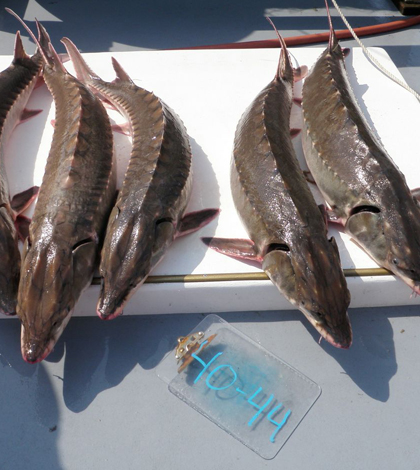Universities team up to track Atlantic sturgeon and prevent accidental bycatch

Due to over-hunting, sturgeon are incredibly rare. The fish, which was pursued for its caviar in the 19th and 20th centuries, has been deemed one of the most endangered fish in the world. Estimates placed the sturgeon population a century ago at 180,000. Today that number sits at 300 adults.
In one of the efforts to protect the endangered fish, researchers at Delaware State University and University of Delaware have teamed up to help fishermen avoid accidentally catching the creature. The project uses an ocean glider, satellites and hydrophone sensors to track surgically implanted acoustic transmitters in Atlantic sturgeon.
Dewayne Fox, associate professor of Fisheries at Delaware State, has been tagging the fish for years. He says working around sturgeons’ tough exteriors can be a challenge.
“Sturgeon in their present form look like they did 73 million years ago. They have five rows of bony plates – ‘scutes’ – overlapping around the body,” said Fox. “Larger plates spread out, so adults will have scutes the size of an appetizer plate. They’re hard like bone.”
Tagging sturgeon means getting past the bony plates, and Fox says doing so is possible by making a small incision in the fish’s abdomen. Tagging older sturgeon is easier because the armor-like plates spread out as the fish matures.
“We cradle the fish in a sling as it comes over the side of the boat and transfer it into a large well,” said Fox. “We add an anesthetic powder to the bath that knocks the fish out, then roll the fish belly up, make a small incision in the abdomen, implant the transmitter and suture it up.”
Each acoustic transmitter is about the size of an index finger and is implanted within an enclosure of silastic, a latex epoxy developed for organ transplant products to minimize rejection rates. After the operation is complete, the anesthetic is pumped out of the water and the fish regains consciousness before it is released.

Atlantic sturgeon are surgically implanted with acoustic transmitters
Which is when Matt Oliver, assistant professor of oceanography at the University of Delaware, can track the sturgeon with a Slocum glider called OTIS, or oceanographic telemetry identification sensor, in Delaware Bay. The glider works with hydrophone sensors moored along the bay, for tracking sturgeon numbers there by picking up the acoustic transmitter signals when sturgeon swim by.
“We started thinking about how the fish utilizes and selects environments of the coastal ocean for a possible regulation of the species to find out how to avoid bycatch – when you catch a species of fish that you’re not intending to catch,” said Oliver. “There’s no one out there trying to catch sturgeon.”
The glider is also giving data on water quality while completing its three-month mission. It pulls in data on oxygen levels, temperature, salinity, currents, clarity and turbidity in addition to a few other parameters. The data will help detect where the fish is most likely to go and Oliver hopes to one day forecast the likely locations of sturgeon so fishermen can avoid those areas.
“Matt’s glider can go where we can’t put hydrophone sensors,” said Fox. “And as it goes on, it collects attributes related to water quality.”

The project’s glider, nicknamed OTIS, detects tagged sturgeon and collects water quality data
The glider’s water quality data may also help in the mission to protect native spawning grounds.
Sturgeon spawn in rivers and then go into the ocean to mature. Luckily, Fox has that part covered. He helped found the ACT (Atlantic Cooperative Telemetry) network, a group of researchers who share data on more than 45 tagged species up and down the Atlantic coast.
“We maintain a network of 150 hydrophone sensors from the coast of Virginia to the Hudson River, working with partners in New Jersey and Pennsylvania,” said Fox. “When a tagged sturgeon swims by, a hydrophone detects it.”
Satellites are used to measure ocean parameters in broad sweeps, interpreting certain conditions into colors which tell researchers what it’s like in a particular area.
The glider, satellite data and acoustic transmitters combine to give researchers a view into what types of water near Delaware Bay attract sturgeon.
“In using the ocean tech that we have, like autonomous vehicles and satellites, it’s easy to see that the hydrology of the coastal ocean is not homogeneous,” said Oliver.
The project touches on some of the main threats to the fish, which include bycatch and habitat destruction that comes when newly built dams keep sturgeon from reaching native spawning grounds. Another threat comes from large shipping boats that use rivers to ferry their goods, Fox says. Sturgeon often reproduce in the deepest water achievable. Since modern shipping boats are so large, their propellers sometimes cross right where sturgeon are spawning.
But if bycatch can be reduced in Delaware Bay, that’s one small win for sturgeon conservation efforts–something that Fox’s tagging has a pulse on.
“Between 2005 and 2007 – fishing in Delaware Bay – we sampled for three years and captured around 30 sturgeon,” said Fox. “This year, we’ve caught 50.”
All photographs taken under the authority of NOAA-NMFS Permit No. 16507





0 comments